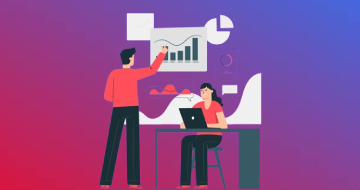IIRF Online > Finance & Accounting > Finance > Chartered Financial Analyst (CFA) > Level 1 CFA® Exam Prep Bootcamp (Part 1/2)
Level 1 CFA® Exam Prep Bootcamp (Part 1/2) by Udemy
Level 1 CFA® Bootcamp: Ethics, Quantiative Methods, Corporate Finance, Economics, and Alternative Investments
Course Highlights
- Prepare for the CFA® Level 1 exam
- Earn one of the most prestigious designations in finance and investment management
- Acquire a solid understanding of key business and finance disciplines
- Impress interviewers by showing a strong an understanding of finance fundamentals and advanced topics concepts
- Study Ethics, Quantitative Methods (Statistics and Probability), Corporate Finance, Economics, and Alternative Investments
- Understand the Global Investment Performance Standards (GIPS)
- Learn about the time value of money, discounted cash flow applications, statistical concepts and market returns, probability and probability distributions, sampling and estimation, hypothesis testing, and technical analysis
- Acquire an understanding of corporate governance, capital budgeting, cost of capital, measures of leverage, and working capital management
- Gain an understanding of fundamental topics like demand and supply, firm and market structure, economic growth, business cycles, monetary trade and capital flows, and currency exchange rates
Skills you will learn!
Curriculum
2 Topics
What Does the Course Cover?
Welcome Gift
7 Topics
Introduction
Setting Up the Financial Calculator
Basic Calculations
Time Value of Money
Cash Flow Analysis
Statistics
Depreciation and Breakeven
1 Topic
365 Formula Sheet
7 Topics
LOS Overview
Ethics Explained
The Role of a Code of Ethics for Defining a Profession
Challenges to Ethical Behavior
The Need for High Ethical Standards in the Investment Industry
Ethical vs. Legal Standards
CFA® Ethical Decision-Making Framework
6 Topics
LOS Overview
Structure of the CFA® Institute Professional Conduct Program
Components of the Code of Ethics® and the Standards of Professional Conduct®
Ethical Responsibilities Required by the Code and Standards
Practice Questions (Code of Ethics and Standards of Professional Conduct)
Practice Questions with Answers (Code of Ethics and Standards of Professional..)
24 Topics
LOS Overview
Professionalism I A Knowledge Of The Law
Professionalism I B Independence and Objectivity
Professionalism I C Misrepresentation
Professionalism I D Misconduct
Integrity of Capital Markets II A Material Non-Public Information
Integrity of Capital Markets II B Market Manipulation
Duties to Clients III A Loyalty Prudence and Care
Duties to Clients III B Fair Dealing
Duties to Clients III C Suitability
Duties to Clients III D Performance Presentation
Duties to Clients III E Preservation of Confidentiality
Duties to Employers IV A Loyalty
Duties to Employers IV B Additional Compensation Arrangements
Duties to Employers IV C Responsibilities of Supervisors
Investment Analysis Recommendations and Actions V A Diligence and Reasonable
Investment Analysis Recommendations and Actions V B Communication With Client
Investment Analysis Recommendations and Actions V C Record Retention
Conflicts of Interest VI A Disclosure of Conflicts
Conflicts of Interest VI B Priority of Transactions
Conflicts of Interest VI C Referral Fees
Responsibilities as a CFA® Institute Member or CFA® Candidate VII A
Responsibilities as a CFA® Institute Member or CFA® Candidate VII B
Standards of Professional Conduct - Overview
4 Topics
LOS Overview
The Global Investment Performance Standards®
Composites Construction
Requirements for Verification
9 Topics
LOS Overview
Key Features of GIPS®
Fundamentals of Compliance
Scope of GIPS®
GIPS® Implementation
Overview of the Global Investment Performance Standards®
Practice Questions (Global Investment Performance Standards®)
Practice Questions with Answers (Global Investment Performance Standards®)
GIPS® Overview
19 Topics
LOS Overview
Time Value of Money
How to Use a Timeline to Depict Time Value of Money Problems
How to Interpret Interest Rates
Interest Rates as the Sum of Several Components
Calculate and Interpret an Investment's Effective Annual Rate
The Relationship between PV and FV
Solving Different Time Value of Money Problems
The Importance of Compounding Frequencies
Ordinary Annuity
Annuity Due
Perpetuity
FV and PV of Unequal Cash Flows
Calculate the Monthly Payment of a Mortgage Loan
Let's Calculate the Number of Years it Takes to Achieve a Financial Goal
What is the Rate of Return of an Investment?
The Cash Flow Additivity Principle
Practice Questions (Quantitative Methods - Time Value of Money)
Practice Questions (Answers with explanations)
13 Topics
LOS Overview
How to Interpret the Net Present Value (NPV)
Calculate NPV
Calculate an Investment's Internal Rate of Return (IRR)
Compare NPV and IRR
The Holding Period Return
The Money-Weighted Rate of Return
The Time-Weighted Rate of Return
Evaluate the Performance of Money Market Instruments
Alternatives to the Bank Discount Yield
Convert Among Yield Measures
Practice Questions (Quantitative Methods - Discounted cash flow applications)
Practice Questions (Answers with explanations)
19 Topics
LOS Overview
Fundamental Concepts of Statistics
Measurement Scales
Parameter Sample statistic and Frequency Distribution
Interpret Frequency Distributions
Graphical Representation
Measures of Central Tendency
Measures of Central Tendency - Mean Median Mode
Quartiles Quintiles Deciles and Percentiles
Range and Mean Absolute Deviation
Variance and Standard Deviation
Semi-variance and Semi-deviation
Chebyshev Inequality
Coefficient of Variation and Sharpe Ratio
Explain Skewness
Behavior of the Mean Median and Mode
Sample Skewness
Kurtosis
Compare the Use of Arithmetic and Geometric Means
21 Topics
LOS Overview
Probability Definitions
The Two Defining Properties of Probability
Defining Probabilities as Odds
Dependent Events vs. Independent Events
Conditional Probability
The Addition Rule
The Multiplication Rule
The Total Probability Rule
Summary Lesson: Addition Multiplication and Total Probability Rules
Practical example: Total Probability Rule
Conditional Expectation in Investment Applications
The Relationship between Financial Securities
Calculating Covariance
Correlation
Expected Value
Calculating the Variance of a Random Variable
Portfolio Expected Returns and Variance
Covariance Based on a Joint Probability Function
Bayes Formula
Principles of Counting
21 Topics
LOS Overview
Defining a Random Variable
Discrete and Continuous Random Variable
Cumulative Distribution Function
Practical Exercise
Uniform Bernoulli and Binomial Random Variables
Discrete Distribution Functions
Discrete Uniform Distribution
Binomial Distribution
Practical Exercise
Continuous Uniform Distribution
Properties of the Normal Distribution
Univariate vs. Multivariate Distributions
Comparison between Conclusions Draw with Chebyshev and Normal Distribution
Standard Normal Distribution
Using Z-values to Calculate Probabilities
Safety-first Ratio Roy's Criterion for Portfolio Optimization
Lognormal Distribution
Discrete vs. Continuous Compounding
Monte Carlo Simulation
Historical Simulation
14 Topics
LOS Overview
Statistical Inferences
Sampling Error
Stratified Random Sampling
Time Series vs. Cross-sectional Data
Central Limit Theorem
Standard Error of the Sample Mean
Estimator of a Population Parameter
Confidence Intervals
Student's T-distribution
Calculating Confidence Intervals - Known Variance
Calculating Confidence Intervals - Unknown Variance
Calculating Confidence Intervals - Variance Unknown Large Sample Size
Sampling Bias
17 Topics
LOS overview
Defining Hypothesis Testing
One and Two-sided Hypothesis Tests
What Is a Test Statistic?
The Type I and Type II Errors. Definition of Significance Level
What Is a Decision Rule?
How Do We Measure the Power of a Test?
The Relation Between Confidence Intervals and Hypothesis Tests
Statistically vs. Economically Meaningful Results
How Do We Measure and Use P-values?
Hypothesis Testing - Variance Known
Hypothesis Testing - Variance Unknown
Hypothesis Testing - Equality of Means (Equal and Unknown Variances)
Hypothesis Testing - Equality of Means (Unequal and Unknown Variances)
Hypothesis Testing - The Difference of Two Means
Testing for the Variance - Chi-Square Test
Parametric vs. Nonparametric Tests
16 Topics
LOS Overview
Corporate Governance: Description
Stakeholder Groups and Their Interests
Stakeholder Conflicts
Stakeholder Management
Governance Mechanisms
Board of Directors
Board of Directors Committees
Factors Influencing Corporate Governance
Corporate Governance: Risks and Benefits
Principles of Corporate Governance Analysis
Environmental Factors and Social Considerations in Investment Analysis
ESG Investing
ESG Investing vs Fiduciary Duties
Practice Questions (Corporate Governance and ESG: An Introduction)
Practice Questions (Answers with explanations)
17 Topics
LOS Overview
The Capital Budgeting Process
Basic Principles of Capital Budgeting
Engaging with Multiple Projects at a Time
Net Present Value (NPV)
Net Present Value: Example
Internal Rate of Return (IRR)
Payback Period
Discounted Payback Period (DPBP)
Average Accounting Rate of Return (AAR)
Profitability Index (PI)
NPV Profile
Compare the NPV and IRR Methods
Problems Associated with IRR
The Relation Between NPV and Share Price
Practice Questions (Capital Budgeting)
Practice Questions (Answers with explanations)
19 Topics
LOS Overview
The Weighted Average Cost of Capital (WACC)
Effect of Taxes on the Cost of Capital
Use of Target Capital Structure in Estimating WACC
Marginal Cost of Capital (MCC)
The MCC's Role in Determining the NPV
Calculate the Cost of Debt
Cost of Preferred Stock
Calculate the Cost of Equity
Components of CAPM
Calculate the Cost of Equity with the Dividend Discount Model
Bond Yield Plus Risk Premium Approach
Calculate and Interpret Beta
Calculate a Project's Beta
Estimate the Cost of Equity for Developing Countries
Marginal Cost of Capital Schedule
Flotation Costs
Practice Questions (Cost of Capital)
Practice Questions (Answers with explanations)
11 Topics
LOS Overview
Measures of Leverage
Business and Financial Risk
Calculate the Degree of Operating Leverage (DOL)
Calculate the Degree of Financial Leverage (DFL)
Calculate the Degree of Total Leverage (DTL)
The Effect of Financial Leverage on a Company's NI and ROE
Calculate the Breakeven Quantity of Sales
Calculate the Operating Breakeven Quantity of Sales
Practice Questions (Measures of Leverage)
Practice Questions (Answers with explanations)
18 Topics
Working Capital Management (Overview)
Working Capital Management (Definition)
Liquidity Management
Liquidity Measures
Asset Management Ratios
Payables Turnover Ratio
Liquidity Analysis (Example)
Operating and Cash Conversion Cycles
Net Daily Cash Position
Yields on Short-Term Securities
Investment Policy Statement
Accounts Receivable Management
Inventory Management
Accounts Payable Management
Short-term Bank Funding Sources
Short-term Non-bank Funding Sources
Practice questions (Working Capital Management)
Practice questions (Working Captial Management)-answers
10 Topics
LOS Overview
Basic Concepts
Elasticity
Income and Substitution Effects
Exceptions to the Law of Demand
Diminishing Marginal Returns
Break-even and Shutdown Analysis
Economies and Diseconomies of Scale
Practice Questions (Demand and Supply Analysis)
Practice Questions with Answers (Demand and Supply Analysis)
11 Topics
LOS Overview
Market Structures
Perfect Competition
Monopolistic Competition
Oligopoly
Monopoly
Concentration Measures
Summary of Market Structures
Practice Questions (The Firm and Market Structures)
Practice Questions with Answers (The Firm and Market Structures)
Supplemental Materials
17 Topics
LOS Overview
GDP Calculation
GDP Calculation (Continued)
Nominal and Real GDP
The Expenditure Approach
The Income Approach
Fiscal Balance and Trade Balance
Aggregate Demand
Aggregate Supply
Shifts in Aggregate Demand
Shifts in Aggregate Supply
The Macroeconomic Equilibrium
The Effect of Combined Changes in AD and AS
Sources of Economic Growth
The Production Function
Practice Questions (Aggregate Output Prices and Economic Growth)
Practice Questions with Answers (Aggregate Output Prices and Economic Growth)
15 Topics
LOS Overview
Business Cycle Phases
Resource Use and the Business Cycle
Housing Market and the Business Cycle
External Trade Sector and the Business Cycle
Theories of the Business Cycle
Types of Unemployment
Unemployment Measures
Inflation
Indexes Used to Measure Inflation
Uses and Limitations of Inflation Measures
Cost-Push and Demand-Pull Inflation
Economic Indicators
Practice Questions (Understanding Business Cycles)
Practice Questions with Answers (Understanding Business Cycles)
28 Topics
LOS Overview
Introduction to Monetary and Fiscal Policy
Functions of Money
Definitions of Money
The Money Creation Process
The Quantity Theory of Money
Theories of Money Demand and Supply
The Fisher Effect
Roles and Objectives of Central Banks
Costs of Expected and Unexpected Inflation
Monetary Policy Tools
The Monetary Transmission Mechanism
Qualities of Effective Central Banks
Monetary Policy and Economic Growth
Inflation Interest Rate and Exchange Rate Targeting
Expansionary vs Contractionary Monetary Policy
Monetary Policy Limitations
Roles and Objectives of Fiscal Policy
Fiscal Policy Tools
Effective Tax Policy
Modeling the Impact of Taxes and Government Spending
The Ricardian Equivalence
National Debt-to-GDP Indicator
Fiscal Policy Limitations
Expansionary vs Contractionary Fiscal Policy
Monetary and Fiscal Policy Interaction
Practice Questions (Monetary and Fiscal Policy)
Practice Questions with Answers (Monetary and Fiscal Policy)
13 Topics
LOS Overview
Gross Domestic Product vs Gross National Product
Costs and Benefits of International Trade
Absolute vs. Comparative Advantage
Ricardian and Heckscher-Ohlin Models of Trade
Trade Restrictions
Trading Blocкs
Capital Restrictions
Balance of Payments
Balance of Payments (continued)
International Trade Organizations
Practice Questions (International Trade and Capital Flows)
Practice Questions with Answers (International Trade and Capital Flows)
14 Topics
LOS Overview
Alternative Investments vs. Traditional Investments
Categories of Alternative Investments
Hedge Funds
Private Equity
Real Estate
Other Classes of Alternative Investments
Benefits of Alternative Investments
Hedge Funds - Fees and Returns
Valuation of Alternative Investments
Risk Management of Alternative Investments
Practice Questions (Introduction to Alternative Investments)
Practice Questions with Answers (Introduction to Alternative Investments)
Completing 100%

Level 1 CFA® Exam Prep Bootcamp (Part 1/2)




